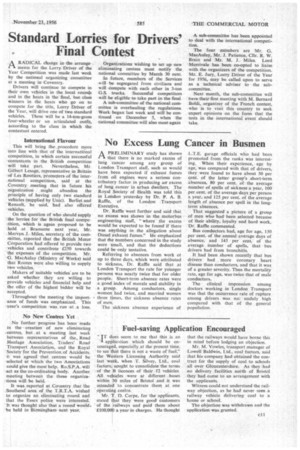No Excess Lung Cancer in Busmen
Page 51

If you've noticed an error in this article please click here to report it so we can fix it.
1-1 A PRELIMINARY study has shown
that there is no marked excess of lung cancer among any group of London Transport staff, such as would have been expected if exhaust fumes from oil engines were a serious contributory factor in producing artexcess of lung cancer in urban dwellers. The Royal Society of Health was told this in London yesterday by Dr. P. A. B. Raffle, of the London Transport Executive.
Dr. Raffle went further and said that no excess was shown in the motorbus engineering staff, "where the excess would be expected to be found if there was anything in the allegation about Diesel exhaust fumes." He emphasized that the numbers concerned in the study were small, and that the deductions could be only tentative.
Referring to absences from work of up to three days, which were attributed to sickness, Dr. Raffle said that at London Transport the rate for younger persons was nearly twice that for older people. Short-term absence rates were • a good, index of morale and stability in a group. Among conductors, single women had twice, and married women three times, the sickness absence rates of men.
The sickness absence experience of L.T.E. garage officials who had been promoted from the ranks was interesting. When their experience, age by age, was compared with that of drivers, they were found to have about 50 per cent, of the latter group's short-term absences, 80 per cent, of the average number of spells of sickness a year, 100 per cent, of the average days per person a year, and 125 per cent, of the average length of absence per spell in the longterm abtences.
That suggested a picture of a group of men who had been selected because of their ability, loyalty and hard work, Dr. Raffle commented.
Bus conductors had, age for age, 130 per cent_ of the annual average days of absence, and 145 per cent. of the average number of spells, that bus drivers had from bronchitis.
It had been shown recently that bus drivers had . more coronary heart disease than conductors, and that it was of a greater severity, Thus the mortality rate, age for age, was twice that of male conductors, The clinical impression among doctors working in London Transport was that the occurrence rate of rupture among drivers was no, unduly high compared with that of the general population.
















































































































